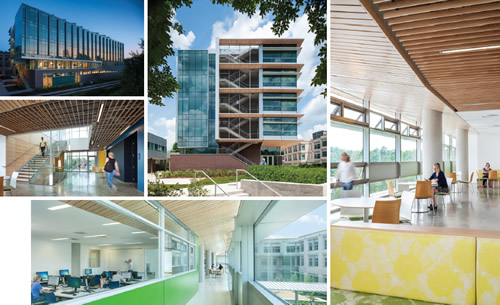Duke University: Nicholas School of the Environment

PHOTOS © WARREN JAGGER PHOTOGRAPHY
Environment Hall on
the campus of Duke University
in Durham, NC, designed by
Payette, is a long narrow bar building
nestled in among existing campus buildings,
giving virtually all program spaces
access to natural light and views. A subtle
bend in the building’s geometry mitigates
multiple campus grids, signifies entry and
is used to create landscape spaces that
are at once cradled and expansive. The
building’s structural grid and floor-to-floor
heights align with the adjacent Levine Science
Research Center, creating a dialogue
between old and new across a protected
orchard while preserving the flexibility of a
future physical link between buildings.
The project integrates low-energy, sustainable
building systems aimed at reducing
environmental impact and serving as teaching
tools for the School and its broader community.
A rooftop solar photovoltaic trellis generates
60,000 kWh of electricity annually and
is complemented with a solar thermal panel
system to satisfy domestic hot water needs.
The trellis shades a garden roof, which functions
as a pair of informal outdoor classrooms.
A low-ambient, high-task lighting
strategy with vacancy sensors and daylight
harvesting reduces lighting energy.
Building-wide, a dashboard monitoring
system monitors and communicates indoor
and outdoor environmental conditions, as
well as indoor energy usage, allowing occupants
to make near real-time adjustments
to reduce energy consumption.
The building’s primary organizing
element is its network of thermal corridors
along the south façade, which utilize a
relaxed temperature strategy to insulate
interior spaces from direct solar gain.
Coupled with tuned horizontal sunshade
elements and operable windows providing
natural ventilation, the thermal corridors
significantly reduce the building’s overall
energy consumption.
A high-performance curtainwall with
a varying ceramic-fritted glazing and
vertical fin sunshades minimizes heat gain.
At the ends of the building, these primary
façade systems wrap the corner and are
stitched together by expressive concrete
stairs, a unique exterior experience made
possible by the site’s temperate climate.
This article originally appeared in the College Planning & Management September 2016 issue of Spaces4Learning.